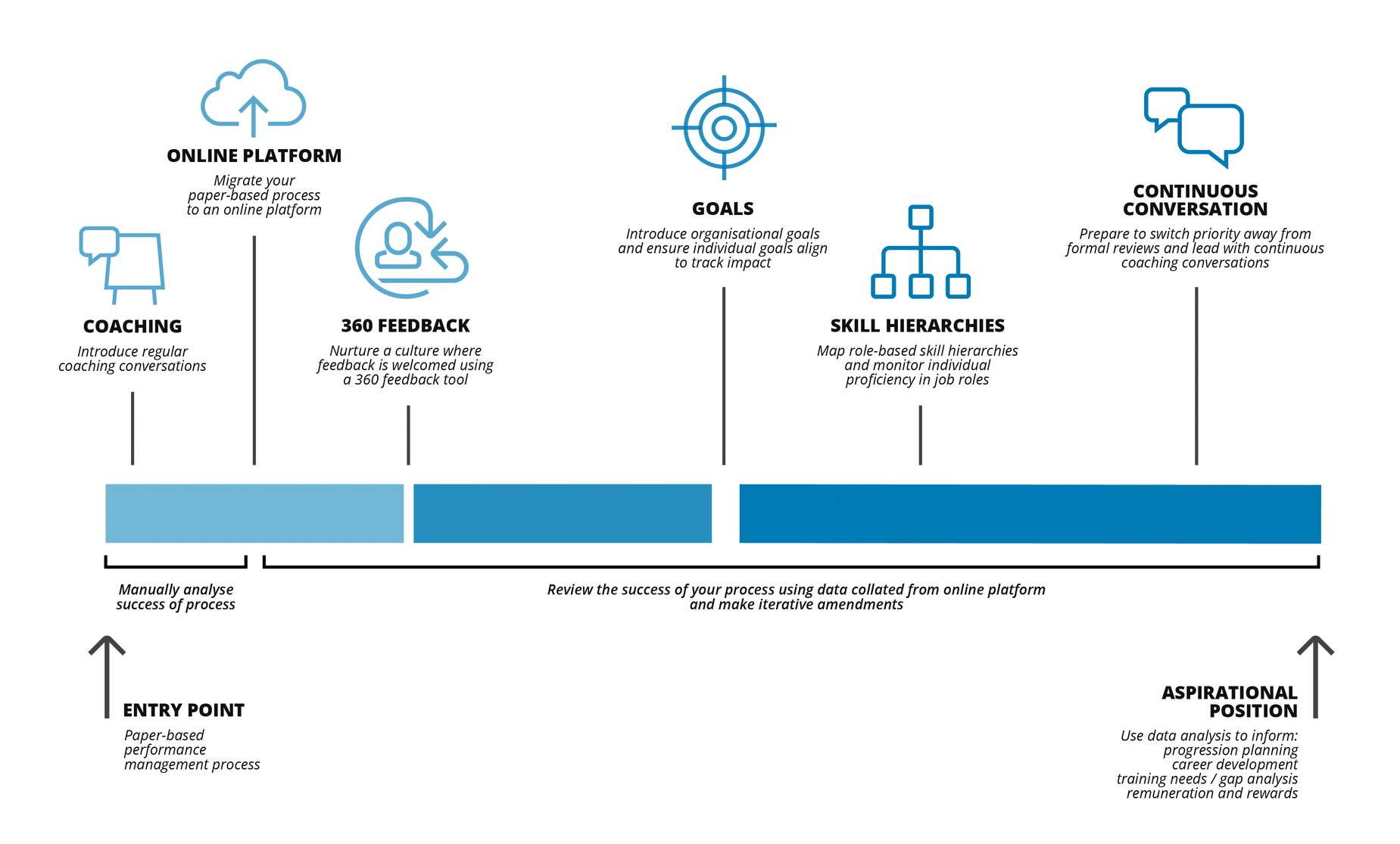Performance. Management.
These two words have sent shivers down my spine and generated a headache for many of my former managers.
But why does something that was designed to be a positive process, to enhance an organization’s goals, get so much bad press?
For many people, performance management is a negative process associated with failure, underperformance and broken promises.
In this blog, I’m going to look at how it’s not all bad in the performance management world and how you can use Totara Perform to support a continuous performance management process. But where to start? Well, “what is performance management?” is a great place.
Where to start: Research
To understand why performance management is often only given last-minute preparation, let’s look at what performance management actually is. The Chartered Institute of Personnel and Development (CIPD), the professional body for experts in people at work, advise that there’s no standard definition of performance management, but states that it involves activities that:
-
Establish objectives through which individuals and teams can see their part in the organization’s mission and strategy
-
Improve performance among employees, teams and, ultimately, organizations
-
Hold people to account for their performance by linking it to reward, career progression and termination of contracts
The problem with traditional performance management practices
It’s quite simple really. It’s not one thing; it’s a few things brought together.
So how did performance management get this negative reputation?
Let’s take a look at a traditional performance management process:
-
An appraisal at the start of the year to share organizational goals and discuss the expectations for the employee and past employee performance
-
An end-of-year review to talk through how the year went from the manager and the employee’s perspective
-
A final rating and, in many organizations, a pay review
This structure, along with the rightly maligned “compliment sandwich” feedback, is increasingly recognized as fundamentally flawed. The annual frequency of feedback does not allow for course corrections during the year – imagine telling somebody they made a mistake as part of their role eleven months ago!
Discussions can also be biased towards historic feedback instead of forward-looking improvements or actions. Traditional performance management practices often leave employees feeling anxious, which can lead to a dip in performance, and even trigger a search for a new job elsewhere.
And for managers, there is the stress of conducting these negatively oriented reviews effectively and in a timely fashion.
Modern performance management practices
Today’s pace of change demands a greater frequency of performance reviews and feedback. Employee expectations have also evolved to demand more autonomy, a clear path to skills mastery and a shared sense of purpose about the work they do.
These are deep motivators that will lead to sustained high performance.
Moving to a more frequent – even continuous – model of performance feedback requires embedding these processes into the normal workflow.
This automatically changes perceptions, encourages more informal and multi-directional feedback, and makes conversations more meaningful for all parties. By design, it removes the obstacles and faulty aspects of traditional performance management practices.
The benefits of continuous performance management are significant:
-
Improved employee engagement and satisfaction
-
More consistent, detailed, and actionable data is gathered from the process
-
Deeper understanding of your staff development needs
-
Training is focused on skills that have the best impact on business performance
-
Reduces time and costs related to performance management
While this is an example of what good performance management should look like, it’s important to remember that it won’t be the same for every organization; let alone every team or even every individual.
The next step? Training
By this point, I was developing a solid understanding of what good performance management looked like.
My next step was to see how an online system would support these processes, so I visited the Totara Academy and completed some of the fantastic available courses.
The introduction to continuous performance management set the scene for me. I then followed this up with courses on:
These courses helped me understand what I was trying to achieve, but also how to achieve it.
Starting a performance management process from a blank sheet seemed a bit daunting at first. So using the knowledge gained from the courses above, I reviewed my organization’s objectives and values and then prioritized our organization’s key mission and vision and how employees influence both.
This is a critical first step because working towards all-important day-to-day goals – such as increasing sales or achieving faster customer response times – isn’t as motivating or effective without the guiding context of the organization’s wider vision.
Once you have a unifying mission to motivate and measure the performance of employees, it’s time to configure a performance management program that fits your unique needs using these five simple steps:
1. Start slow, consult other decision-makers and stakeholders
2. Research and gather feedback from the teams that will be affected
3. Experiment
4. Collect feedback from your employees
5. Use supportive performance management technology
Phase 2: Implementing a coaching culture
After the research phase (take your time!), the next step is to consider how to nurture a friendly coaching culture with regular check-ins in lieu of yearly reviews to accelerate company-wide adoption.
By now, you’ll have read all the documents, books and the studies about continuous performance management, and your organization has decided to overhaul its performance management approach by introducing regular check-ins in place of yearly reviews.
This is a significant organizational change and the first thing to remember is “be patient.” Rome wasn’t built in a day.
When implementing a performance management process from scratch, initiatives are often prematurely stifled because the adoption process is either non-existent, too drastic, overcomplicated or too time-consuming.
It’s therefore worth reinforcing that these practices and procedures should be introduced gradually.
There is no need for a radical uprooting of your existing performance management processes (if you have any). Trying to do too much too soon can backfire by overwhelming employees and making it harder to gain buy-in from managers and staff.
The performance management continuum: A model for all organizations
Using the following performance management continuum model can help you successfully implement your performance management strategy. Let’s explore how this can work in practice.

Every year, studies on employee and workforce engagement are completed and would it surprise you to know that employee engagement and the CIPD Good Work Index survey (previously UK Working Lives) shows that about two-thirds of workers are satisfied with their jobs overall.
Sounds good at first glance, but that means more than a third of the workforce is either coasting or significantly unengaged. Why should we care about that?
Because it’s proven that employee engagement is directly tied to key business outcomes.
Companies with engaged employees had 89% greater customer satisfaction and 50% higher customer loyalty than their disengaged counterparts. (Source: Hay Group)
So, how do we get the members of our team more engaged? There are a number of things that collectively can swing the engagement pendulum, but if I could only pick one thing to start with, it would be coaching and coaching conversations.
First, let’s define coaching; or rather what coaching is not.
Coaching isn’t telling people what to do, it’s helping them come up with their own answers. The key to an effective coaching conversation is asking the right questions in the right way and at the right time.
If you Google coaching models, there are a number of options for you to choose from. I like to use the GROW model (originally developed in the 1980s by business coaches Graham Alexander, Alan Fine and Sir John Whitmore) to help guide the coaching conversation. It’s simple and intuitive.
And as with any skill, if you practice this model, it can become a natural way for you to engage and guide employees.
GROW stands for:
- Goal
- Reality
- Options (or Obstacles)
- Wrap-Up (or Way Forward)
A good way of thinking about the GROW Model is to think about how you’d plan a journey:
1. Goal – Where are you going to? Brighton
2. Reality – Where are you now? Manchester
3. Options – What routes are there? I could go by train or by bus
4. Wrap-Up – Ensure you’re clear on where you’re going and how you’re going to get there
Using the GROW Model means that the coach does not need to be an expert, so any employee with the right skills (active listening and questioning for example) can be a coach.
Once you’ve decided on a model to use, you can start moving towards achieving a coaching culture, which has three main components.
- Informal feedback and day-to-day conversations: enabled through Totara Engage workspaces
- Semi-formal feedback: scheduled check-ins using Totara Perform
- Formal feedback: performance reviews in Totara Perform
Although in reality, line managers are most likely to take the main responsibility for delivering coaching. The coach is a conversation facilitator and helps the employee come up with their own answers, without offering advice or direction.
Most organizations already use a paper or document-based process with no automation in place.
If this is the case in your organization, a first step to improving your performance management practice is to introduce regular coaching conversations via the GROW model.
The simplest way to start your new performance management process
If you currently conduct an annual performance review, try shifting this to quarterly mini-reviews. In doing so, you can simplify and shorten the review process, so it takes less time to conduct.
Everyone will be more receptive to the idea that more frequent conversations are not more time-consuming.
As the frequency of check-ins grows then the need for a formal review diminishes as performance management dissolves into what it should be in the first place: day-to-day good management and job performance.
Stay tuned for the next blog post in this series! I’ll explain how you can efficiently migrate from a manual, paper-based performance management process to an automated employee performance management system.






